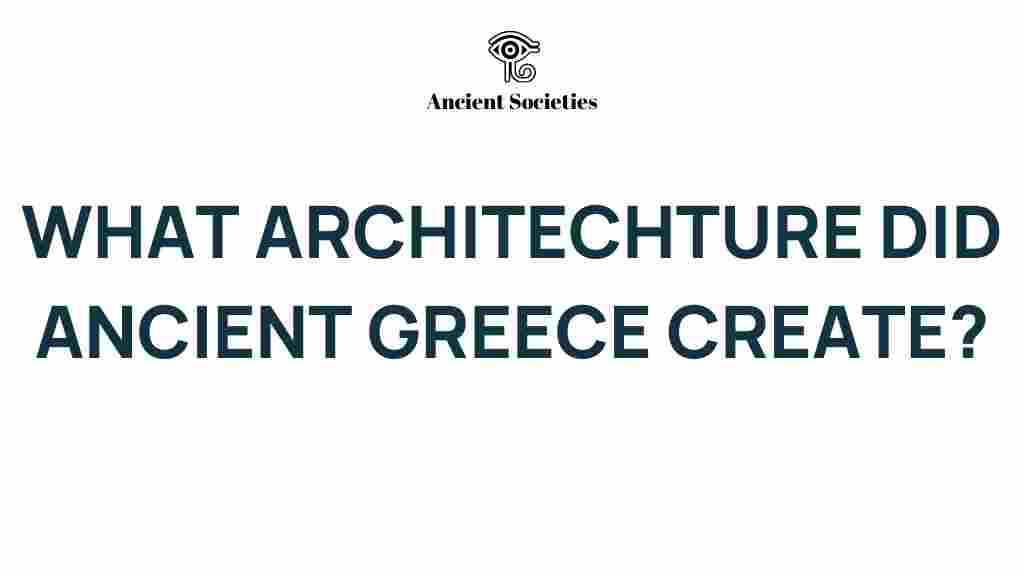Unveiling the Architectural Wonders of Ancient Greece
Ancient Greece is renowned for its remarkable contributions to architecture, which laid the foundation for many modern design principles. The architectural style of this era is not only significant for its aesthetic appeal but also for its complex urban planning and cultural heritage. This article explores the historical buildings, Greek temples, and classical designs that define Ancient Greece’s architectural legacy, emphasizing their archaeological significance and enduring influence.
The Foundations of Ancient Greek Architecture
The architecture of Ancient Greece is characterized by its distinct styles and remarkable structures that have withstood the test of time. The ancient Greeks utilized a variety of materials, most notably marble, which contributed to the durability and beauty of their buildings.
Key Features of Greek Architecture
To appreciate the architectural wonders of Ancient Greece, it’s crucial to understand its key features:
- Proportions: The ancient Greeks emphasized harmony and proportion in their designs, leading to aesthetically pleasing structures.
- Columns: Greek temples are known for their iconic column styles: Doric, Ionic, and Corinthian.
- Symmetry: Symmetrical designs were a hallmark of classical Greek architecture, contributing to their visual appeal.
- Materials: The use of materials like marble and limestone not only added beauty but also durability to the structures.
Exploring Greek Temples
Among the most significant elements of Ancient Greek architecture are the temples, which served as places of worship and demonstration of civic pride. Greek temples showcase the pinnacle of classical design and architectural innovation.
The Parthenon: A Testament to Classical Design
Perhaps the most famous of all Greek temples is the Parthenon, dedicated to the goddess Athena. Located on the Acropolis of Athens, this architectural marvel exemplifies the Doric order and is celebrated for its exquisite proportions and intricate sculptures.
- Architectural Design: The Parthenon measures 69.5 meters in length and 30.9 meters in width, featuring 46 outer columns.
- Artistic Heritage: The temple’s sculptures, including the famous frieze and the statue of Athena Parthenos, highlight the artistic achievements of the era.
- Symbolism: The Parthenon symbolizes the political and cultural power of Athens during its Golden Age.
Other Notable Greek Temples
In addition to the Parthenon, several other temples are noteworthy:
- The Temple of Zeus: Located in Olympia, it housed one of the Seven Wonders of the Ancient World, the Statue of Zeus.
- The Erechtheion: Known for its Caryatids, this temple is unique for its asymmetrical design and sacred significance.
- The Temple of Apollo: Situated at Delphi, it was a major site for oracle worship and featured stunning architectural elements.
Urban Planning in Ancient Greece
Ancient Greek architects exhibited exceptional skills in urban planning, which greatly influenced the layout of cities. Greek city planning focused on functionality and aesthetics, resulting in organized and harmonious urban spaces.
The Agora: Heart of Civic Life
The Agora served as the central public space in Greek city-states, functioning as a marketplace and a hub for social, political, and cultural activities. Key features included:
- Open Space: The Agora was designed as an open area surrounded by important buildings, allowing for gatherings and public discourse.
- Stoa: Covered walkways known as stoas provided shelter and space for shops, fostering economic activities.
- Public Buildings: Temples, council houses, and theaters were strategically placed to enhance community interaction.
Aesthetics of Ancient Greek Architecture
The aesthetics of Ancient Greek architecture are celebrated for their elegance and beauty. The Greeks believed that beauty was an essential quality of life, reflected in their architectural creations.
Elements of Aesthetic Appeal
Several elements contribute to the aesthetic appeal of Ancient Greek architecture:
- Use of Light: Architects designed buildings to maximize natural light, enhancing the visual experience.
- Ornamentation: Intricate carvings and decorative elements added richness to structures.
- Landscaping: The integration of buildings with their natural surroundings created a harmonious environment.
Archaeological Significance of Ancient Greek Architecture
The archaeological significance of Ancient Greek architecture cannot be overstated. The ruins of ancient structures provide invaluable insights into the culture, religion, and daily life of the people.
Contributions to Modern Architecture
Many principles of Ancient Greek architecture continue to influence modern design. Key contributions include:
- Column Orders: The Doric, Ionic, and Corinthian columns are widely used in contemporary buildings.
- Proportion and Symmetry: Modern architecture often draws on the Greek emphasis on balance and proportion.
- Public Spaces: The design of modern plazas and public buildings reflects the Greek focus on community interaction.
Challenges and Preservation
Despite their enduring beauty, many historical buildings from Ancient Greece face threats from pollution, climate change, and urban development. Preservation efforts are crucial for maintaining these cultural heritage sites.
Steps for Preservation
To ensure the longevity of Ancient Greek architectural wonders, several steps can be taken:
- Restoration Projects: Initiatives aimed at restoring and conserving existing structures are essential.
- Legislation: Enacting laws that protect archaeological sites from development is vital for preservation.
- Public Awareness: Educating the public about the importance of these sites fosters a culture of preservation.
Conclusion
Ancient Greece stands as a testament to human ingenuity and creativity, with its architecture showcasing remarkable historical buildings and cultural heritage. From the majestic Greek temples to the thoughtful urban planning, the architectural wonders of Ancient Greece continue to inspire and educate. By understanding their significance and working towards their preservation, we can ensure that these masterpieces of classical design endure for future generations to admire and learn from.
For those interested in exploring more about Ancient Greece and its architectural marvels, you can visit this resource for a deeper dive into their history. Additionally, if you want to see how these ancient principles are applied today, check out this article on modern architecture influenced by classical design.
This article is in the category Archaeology and created by AncientSocieties Team
